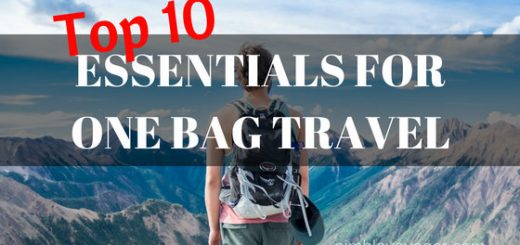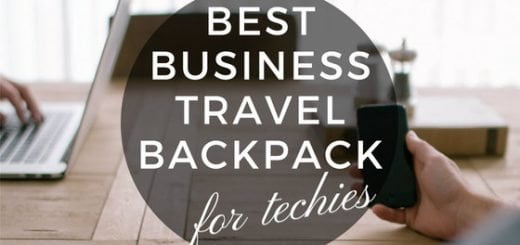Travelling with a Backpack: Ditch Your Suitcase
by The Nimble Voyager · Published · Updated
Disclosure: We may earn a small commission from some of the products mentioned in this post. If you click a link and make a purchase - at no additional cost to you - you help us keep this site online. Thank you for your support!
Most seasoned travelers already have a luggage style preference. They’ve voyaged many miles and know how and what to pack. However, many still drag a roller bag with them. I’m going to explain the virtues of travelling with a backpack and explain all the benefits of ditching your roll-around suitcase.
A New Way of Thinking About Luggage
I know what you’re thinking. Backpacks are only for students or young European travelers, and I don’t want all that weight on my back. But fear not! These days, there is a comfortable backpack for every travel occasion and person, big or small. They come in so many shapes and styles, you may quickly be overwhelmed by the sheer number of choices. One can go basic and utilitarian or sleek and classy. Whatever your style preference and need, there is a backpack to suit you.
Let’s take a look at why travelling with a backpack is easier and better than lugging around a rolling suitcase.
Advantages of Travelling with a Backpack
There are many advantages of travelling with a backpack. These include comfort, peace of mind, and being prepared. Let’s look deeper at these benefits.
Be Safe and Comfortable
For starters, when worn properly, a backpack is ergonomic and will actually help to strengthen your back. Choose a pack that will give you the correct lumbar support, where the weight is distributed properly on your shoulders and hips. You can use the straps to adjust the pack to your height and to help balance your load. Your hands will be free too!
Never Lose Your Belongings
You can always have all of your stuff with you. If you are in between accommodations and want to do some sightseeing until you’re able to check in at your next destination, there is no need to leave your baggage with the concierge (unless you want to!). You can carry it securely with you and everything is right there if you need it. Also, you won’t need to check any luggage at the airport! The versatile design of a backpack makes it easy to store in that overhead bin or tuck underneath your seat. Those with compression straps can shrink even smaller to stow in tight spaces.
Stay Organized
Many backpacks have lots of pockets and compartments, keeping all of your belongings organized and within easy reach. You can’t say that about most roll-arounds! Need your water bottle? It’s in the side pocket. Need to show your passport? A flick of the wrist opens that small top zipper and there it is. Now where’s that cell phone? In its own front pocket with a flap!
Be Prepared for Anything
Are you caught in a rainstorm? Good thing you chose a water-resistant backpack! Suddenly find yourself in a crowded terminal or event? You can maneuver through those throngs of people easily carrying a backpack instead of dragging a bulky roll-around suitcase for people to trip over.
With so many compartments in a backpack, you can pack a surprising amount. And yet, having a backpack forces you to pack as light as possible, to only take the bare essentials. This is something everyone should do anyway when going on a trip. It will save you from having to check luggage, thus saving on those annoying baggage fees most airlines impose. Plus, there’s no running to baggage claim to pick up your luggage at your destination!
Now here is where the fun begins!
How to Choose the Best Backpack for You
There are a number of factors to consider when choosing your backpack, including what type of trip you will be going on, your particular style, and the level of comfort you are going to need when carrying the backpack.
When you’re carrying all of your essential belongings with you on your back, you want to consider not only the type of backpack, but how to pack your stuff effectively. Distribute the weight evenly so that your body can comfortably carry the load. This promotes better posture when you are navigating the busy streets of Tokyo, running to catch a connection in Sydney, or climbing a steep section on the Appalachian Trail.
Regardless of the type you choose, you will want a pack with padded shoulder straps and a top handle. The handle makes it easy to pick up at a moment’s notice and for traveling short distances where you don’t necessarily want to throw it on your back. Opt for a pack with padded straps that are made of breathable mesh to keep you cool.
Let’s look at some specific types of packs and how to ensure that your pack fits your body appropriately.
For Hiking
Great for the outdoors and those multi-day through-hikes, many hiking-specific packs have contoured aluminum or plastic internal frames for weight distribution, which provides comfort and stability over rough terrain. They tend to be larger than your average backpack to hold camping and cooking gear. Hiking packs also feature sternum straps and hip belts for load transfer – these might be overkill for strolling around a city but will really save your back when you’re hiking for hours! These backpacks are usually made of ripstop nylon or polyester and may be TPU-coated for water resistance, or come with a removable waterproof cover.
For Long Trips
Get a backpack that has separate compartments for clothing/shoes, gadgets (yes, you can buy one that will specifically hold your laptop, phone and camera!), and smaller items such as passport, wallet, toiletries, etc. You can find packs that have upper compartments, lower compartments, front flap organizers and the like. The idea is that you should be able to access whatever you need within seconds since it has its own compartment. Choose a pack made of ultra-durable ripstop nylon/polyester for those countless hours of wear and tear.
For Style
Are you the rugged and outdoorsy type? The sophisticated city-slicker type? Or something in between? Choose a backpack that’s aesthetically pleasing to you, but remember that function is more important than form here. In addition, it’s always fun to give your backpack some personality by adding patches, key fobs, etc. that will differentiate your pack from the rest. This makes it easier to quickly identify your pack as well!
Choose a Pack that Fits Your Body
Depending on your torso length, backpacks run from extra-small to large and tall. If you don’t know what size fits you best, go to an outfitter like Cabela’s or REI and try on a few. Talk to the staff – they can give you advice and help you choose. They will often throw weighted beanbags into a backpack and have you walk around the store with it on to test the fit and weight distribution on your body. Having the correct size helps to ensure long-term comfort. An ill-fitting backpack will quickly cause aches and pains!
The shoulder straps should be padded and adjusted to hold the weight close to your body, but the majority of it should rest evenly on your hips with a proper hip belt. Along with fit, the inside volume is important. You don’t want to take an 80-liter pack on a weekend trip; it’ll be too large and you’ll be carrying a heavier pack for no reason. The conventional rule is to take a 30 – 45-liter pack for overnight, a 45 – 60-liter pack for weekend trips, and 55+ liter for longer stays. However, we’re proponents of minimalist, lightweight travel and we suggest staying within the 30-45 liter range for all journeys. Not only do smaller packs limit how much you carry, this range fits into most overhead bins on airplanes.
Final Thoughts
There is a backpack out there that is perfect for you. Whether your trip is short or long, your style is rugged or sleek, there is a pack with room for all of the items you need for your particular situation. To choose a backpack that will be your long-time friend, take the time to consider all of the options available to you, and try on several options before buying one.
It bears repeating: the idea is to pack ONLY what you absolutely need. Minimalist packing will save you time, money, and a backache! No matter where you are going or what you are doing, travelling with a backpack is convenient for any sort of travel plan.



